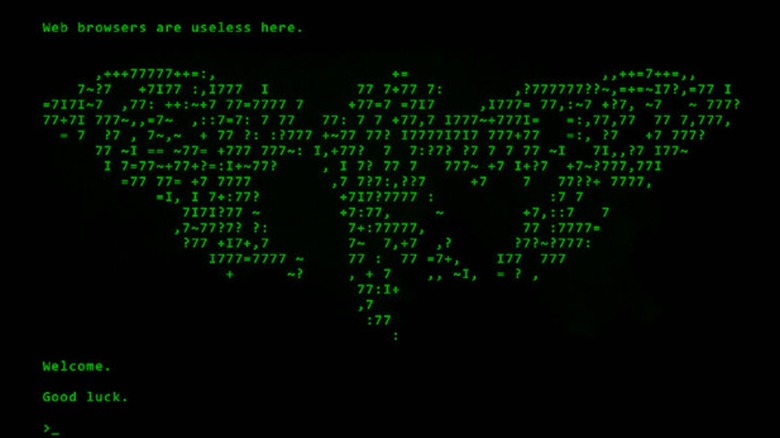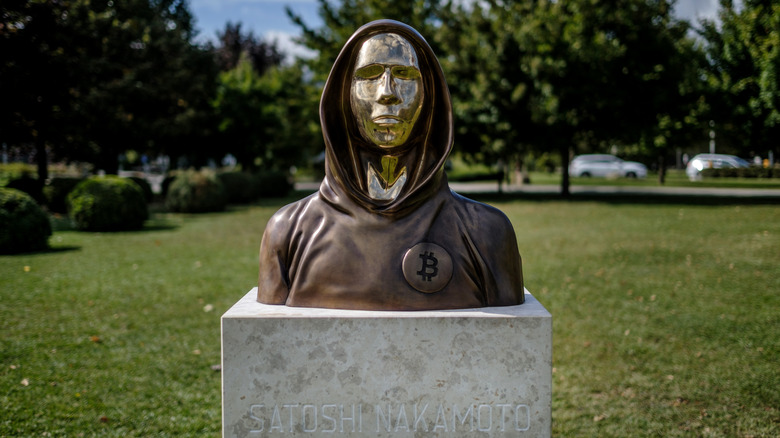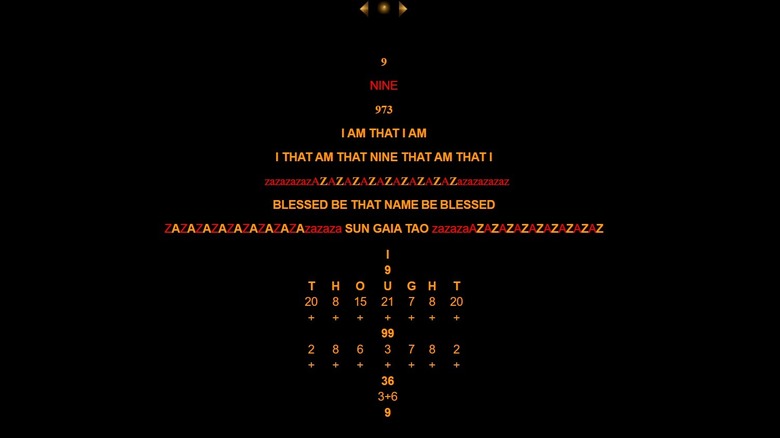The Strangest Internet Mysteries That Are Still Unsolved
The internet, one of the most life-changing technologies in human history, has been around for a few decades now — and like most great, sprawling, labyrinthine places that have been around for a long time, one can find a lot of really weird things there if one knows where to look. From its very earliest days, the net has been a place where relative anonymity allows people to play mind games, throw up weird puzzles, and leave bread crumbs leading to who knows where. In the digital domain, you can never really be sure who or what you're interacting with. It could be the shut-in down the street, an international spy in a far-flung country — or even a ghost in the machine.
Okay, so there are no literal ghosts, but some of the folks responsible for the internet's most enduring mysteries might as well be. If you've ever fallen down a rabbit hole wondering just who on Earth could be responsible for a series of cryptic posts, a creepy YouTube video guaranteed to give you nightmares, or an entire website that seems to have been generated from inside the mind of someone who belongs in a straitjacket, you are certainly not alone. All of these things and more have been puzzled over for decades by those who have fallen into some of the web's darkest corners — and many of these mysteries, like the ones presented here, seem very unlikely to ever be solved.
Markovian Parallax Denigrate
One of the oldest mysteries of the Internet dates back to the mid-'90s, even before the advent of the World Wide Web, when the message board Usenet — basically a great big huge forum, like an early version of Reddit, which has been in existence since 1979 — was still in widespread use. Users could (and still can, with the right service provider) use the protocol simply to retrieve and store text-based messages, and in 1996, a series of such messages began appearing which confounded everyone. They consisted of long strings of seemingly unrelated words, appearing to have no apparent meaning, and they might not even have been connected to each other if not for the one thing they had in common: their enigmatic subject line, "Markovian Parallax Denigrate."
Despite the best efforts of internet sleuths, nobody was ever able to parse out any meaning behind the posts. Roughly a decade after the fact, the one surviving post on Usenet's archives was found to be associated with an email address once belonging to a Susan Lindauer (pictured). That happens to be the name of a former journalist and well-known conspiracy theorist — but she has asserted that she's not the Susan Lindauer associated with that email address, and whoever is has yet to be found.
The posts have been the subject of widespread speculation — perhaps they're an early attempt at text generation, some kind of complex cypher, or just the rambling of a troll. Nobody knows, and it appears that nobody ever will.
A858
In 2011, Reddit users uncovered a set of mystery posts in a mysterious subreddit titled "r/A858DE45F56D9BC9," or simply "A858" for short. The posts that appeared there for several years consisted of long strings of numbers and letters, seemingly completely random, that sure looked like some type of cipher or code. Before long, another subreddit — "Solving_A858" — popped up, with users attempting to decrypt whatever messages the unknown poster might be trying to impart.
Eventually, some of those users actually were able to decipher a few random messages — but they weren't particularly meaningful, nor did they point to any larger purpose behind the posts. In 2015, the subreddit went private, with a message simply telling users that whatever A858 was, it had "concluded" — and the following year, a post titled "Some closure" in "Solving_A858" seemed to confirm, however vaguely, users' suspicions that there was a method to the posts' madness.
Authored by one of that subreddit's moderators, the post explained that they had been in contact with someone connected to the "project," and that it had been "funded by an unknown (to us) company for an unknown (to our contact) purpose." It elaborated that this mysterious contact had been paid to make the posts, which had indeed contained elaborate puzzles, few of which had been solved, along with "random data that was encrypted." A858, the mod concluded, had been permanently shut down "even though it remains mostly unsolved" — leaving the question of its purpose, and who was behind it, unanswered.
Unfavorable Semicircle
One of the most bizarre and impenetrable channels on YouTube, "Unfavorable Semicircle" was created in early 2015. It began to upload videos a few days after its creation, and what videos they were. Their imagery, sometimes static and sometimes not, was blurry and nondescript; their audio tracks ranged from total silence to glitchy noise to shrill, high-pitched squeals, and sometimes, a man's voice could barely be heard in the background, reciting numbers or strings of numbers. Their length ranged from a few seconds to over eleven hours — and if it was some kind of test channel, like the infamous Webdriver Torso, it was unclear what it might be testing.
Internet detectives attempted to take the videos apart, using spectrometers to analyze the audio, searching for some kind of clues in the imagery, and poring over the videos' titles — often with names like "BRILL" or "BROTHER" followed by an ascending numerical sequence — to no avail. Some videos somehow went on for longer than their allotted run time, and others, like one titled "LOCK" and its seeming sequel "DELOCK," would even crash browsers or video players. And there was no shortage of videos to analyze, as, at its peak, the channel was literally uploading a new one every ten seconds.
In 2016, after a BBC report on the channel, YouTube deleted it and all of its videos — and while a meager few have been archived, it seems unlikely that the videos' puzzle, if there was one, will ever be solved.
The Most Mysterious Song on the Internet
In 2007, a web denizen with the screen name "bluuue" posted a snippet of a song that she said had been taped by her brother from a German radio station in 1984. Among loads of such tapes featuring tons of popular synth-pop songs of the day, this song — a dreary, dreamy tune with a near-indecipherable monotone vocal — was an outlier. The reason was not because of its sound, which was fairly typical of all the material to be found in the brother's collection, but because neither she nor her brother could identify the tune, or the artist. As it turned out, neither could anyone else.
Slowly but surely, the tune attracted attention from mystery and synth-pop buffs, none of whom had any luck pinning down its origins, or even making sense of its lyrics; at some point, a full version of the song leaked, posted from a user who had received it from "bluuue" after requesting it by email.
In 2019, Rolling Stone got hold of the story, and neither the man who did the taping (who asked to be identified as "Darius") nor his sister had any new information. Neither did one of the two DJs who might have played the song, Paul Baskerville, who shared that the playlists from that era had all been trashed, and that the only other DJ who might have spun the tune was long deceased. The "Most Mysterious Song on the Internet" remains, for now at least, a mystery.
John Titor
The story of John Titor is a complex one, but here's the gist. In 2000, somebody with the screen name "TimeTravel_0" began posting on several forums, notably on that of the Time Travel Institute. "John Titor" proceeded to spin a yarn over many posts that was, put simply, unbelievable: he was an actual time traveler from the year 2036.
In his future, there had been a civil war, followed by a limited nuclear exchange between the U.S. and Russia. Society was recovering, but there was a bug in "various legacy code computer programs" — one that could only be fixed with an old-school IBM 5100 computer, which he had traveled to 1975 to procure. He was on a brief layover to attend to family business in 2000, and was happy to answer questions.
As one might imagine, there were indeed many questions. "Titor" posted pictures and schematics of his "time machine," went into detail about his worldline (which, he pointed out, would necessarily differ from ours simply by his being there), and eventually disappeared — ostensibly back to 2036 — after bidding his audience goodbye. The veracity of his story and description of his worldline can obviously never be verified, as nobody knows whether time travel is actually possible, but one thing was — the quirk in the programming of the 5100, which supposedly made it capable of interfacing with 2036 systems, was confirmed by an IBM engineer to be real (via Post Bulletin), which was not a widely known detail.
Cicada 3301
Between 2012 and 2014, a mysterious individual or individuals mounted, once annually, the mother of all internet puzzles. The first post appeared on the infamous bulletin board 4Chan, and it featured an image of a Cicada along with the following text: "Hello. We are looking for highly intelligent individuals. To find them, we have devised a test. There is a message hidden in this image. Find it, and it will lead you on the road to finding us. We look forward to meeting the few that will make it all the way through. Good Luck. 3301."
The puzzles were, to put it mildly, formidable. They required knowledge of everything from coding and encryption to incredibly obscure literature to code-breaking, and players who were good enough found themselves faced with yet more puzzles. And not just online, either, but also in the real world, in the form of QR codes posted in locales around the globe.
Only one man who has ever completed the puzzle, in its first year, has spoken about it — and while the final destination was a Tor site, he was not allowed entry, as the game had been shut down due to too many players pooling resources. ("We want the best, not followers," a message on the site read.) Whatever lay beyond that final barrier is shrouded in mystery to this day — for if anybody has ever met the requirements of "Cicada" and passed that final test, none of them have ever come forward.
[Featured image by Rastko Milenkovic via Wikimedia Commons | Cropped and scaled | CC BY-SA 3.0]
The Jack Froese Emails
In 2012, the BBC reported on a Pennsylvania man named Jack Froese, who had suddenly died of a heart arrhythmia the previous year. Other than the fact that Froese was only 32, there was nothing unusual about his death. What was unusual was the fact that a handful of his friends and relatives had begun receiving emails from his account, written in his voice, referencing not only events that had happened recently, but things that only Froese was likely to have known.
Now, there do exist services that allow you to compose emails to your loved ones that go out in the event of your death, but this seems highly unlikely given the fact that Froese's death was quite unexpected. There's also the one missive received by his cousin Jimmy McGraw, which lamented that "Froese" had known that McGraw was going to break his ankle and had tried to warn him — an injury which had happened only a week before. Froese's best buddy, Tim Hart, received an email as well — one profanely imploring him to tidy up his attic, referencing a private conversation the pair had had in that very attic just before Froese's death.
Froese's email account did not appear to have been hacked, and family members such as Froese's mother denied having anything to do with the communications — but as far as Hart is concerned, no explanation was necessary. "If somebody is messing around, I don't care," he said. "I take it for what I want."
Satoshi Nakamoto
The idea behind Bitcoin, and cryptocurrency in general, is fascinating on its own merit; a decentralized currency, outside of the control of the government, the value of which is determined solely by "We the People" sounds like a great idea on paper. But crypto has had a rocky journey into the mainstream; while Bitcoin looks like it is here to stay, there have been more failed cryptocurrencies than you can shake a stick at, and estimates for the average lifespan of a new token range from 15 months to three years. It also stands to reason that, for all its supposed egalitarian purposes, Bitcoin founder Satoshi Nakamoto has probably gotten quite rich — but the untold truth of Bitcoin is that, quite literally, nobody knows who they are.
This seems unfathomable, and of course, it's not as if nobody has ever laid claim to the identity. Among several people who have claimed to be the enigmatic founder, perhaps the most notable is Australian computer scientist Craig Wright, who has provided evidence (all of it circumstantial) to back up his assertion. Wright has also gotten litigious about those who have publicly doubted him, and been the subject of a lawsuit by a united coalition of crypto companies imploring a London court to declare his claim to be invalid.
For now, we are no closer than we have ever been to discovering Nakamoto's true identity — and as you can see by the bust erected in Budapest's Graphisoft Park (pictured above), he is expected to remain anonymous.
Sad Satan
In 2015, a YouTuber known only as "Jamie" — proprietor of the channel Obscure Horror Corner — sat for an interview with Kotaku to discuss a series of four recent posts. The posts showed a playthrough of a horror game titled "Sad Satan," which Jamie claimed he had downloaded from the deep web. Based on the videos, the game — in which the player simply moves in first person through a series of dark hallways — appeared to be one of the most stressful video games ever made; creepy in a truly disturbing way, glitchy in a weirdly purposeful way, visually difficult to look at, with an increasingly discordant soundtrack.
Jamie's story got even weirder. Apparently, the first version of the game he played would very briefly flash shocking, violent, and explicit images; the next version, the one made available for reviewers and the like to play, flashed much less graphic imagery (although those images, like one of disgraced British media personality and convicted pedophile Jimmy Savile, stayed in keeping with a theme of child abuse).
Jamie claimed to have deleted the game from his computer after it kept generating gibberish-laden text files on his desktop, and after the Kotaku piece was published, some claimed to have found the original, graphic version of the game, and that it had corrupted their computers (no evidence of this was given, however). After the "Sad Satan" posts, Obscure Horror Corner stopped posting altogether — and the game, along with whomever might have created it, has since faded into legend.
Mortis.com
In the late '90s, a 4chan user stumbled across a website landing page, a stark black screen with nothing but fields for username and password, by the name of Mortis.com. The user soon noted a couple of interesting things about the website behind the page — namely, that there was apparently a whole lot of data, terabytes worth, behind that innocuous login screen. Also, whatever that data comprised, it seemed to be something that someone didn't want just anyone to see, because try as they might, the user was unable to make a dent in its security.
Soon, other 4chan users got in on the act, but whatever information they managed to dig up only raised more questions. Experienced coders were unable to gain entry; none of the site's pages were archived anywhere on the internet; and, although it was determined that the domain name was registered to a Thomas Ling, it turns out that the name is pretty common, and the Thomas Ling who registered the domain could not be tracked down.
Digital breadcrumbs led amateur investigators into the site to some odd places — other, similarly enigmatic websites hosting nothing but mundane images, tenuous connections to deceased individuals and vacant properties — but absolutely nothing solid hinting at what the site's actual purpose might be. Speculation, of course, ran rampant; was it an info drop for spies? A prototype streaming service? A repository for illicit media? Nobody knows, and as the site is long defunct, nobody is ever likely to.
973-eht-namuh-973.com
Of all the bizarre mysteries the internet has ever presented, a website titled 973-eht-namuh-973 is unique for a couple of reasons: for one thing, it's still active, and if you click that link, you can investigate it for yourself right now. If you choose to do so, however, be aware that you might be signing up for a long trip down a very deep rabbit hole, because another thing that makes 973-eht-namuh-973 unique is its immense size: by some estimates, the site may contain upwards of 100,000 links, leading to an untold number of pages.
Pictured above is a typical page on the site, and as you can see, it can't exactly be called gibberish; it definitely has its preoccupations, such as the Egyptian pantheon of gods, numerical sequences and ciphers in which numbers correspond to letters of the alphabet, and in particular, the number 9. The site was allegedly created by a mysterious figure named David Denison, who has had not one word to say about his intent.
There is, though, a forum where users can discuss their journeys, and yes, there are a handful of posts from those who claim to have "gotten it," to have deciphered whatever message it's trying to impart. As one might expect, though, they're not about to spill the beans, if indeed there are any to spill — because, as one such user put it, "Wisdom comes through work. Should you be granted everything, you wouldn't progress."








